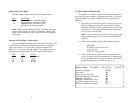
25
The NetLink-T1™ receiving a RL can be in one of the following states:
RxPr The NetLink-T1™ is receiving a preparatory pattern.
Sack The NetLink-T1™, upon receiving a preparatory pattern,
sends an acknowledgement message.
RL The NetLink-T1™ is in remote loopback mode.
RxTr The NetLink-T1™ is receiving a terminate loopback mes-
sage.
Wt1s The NetLink-T1™ is waiting for a sequence of all ones
and will time out if it does not receive it.
IdleP The NetLink-T1™ is sending a QRSS, 511 or 2047 pat-
tern.
Off The NetLink-T1™ is in local loopback.
Test Pattern Idle
(default)
Options: Idle or Sending
To send a pattern, press the ‘c’ key and press <spacebar> to send
the test pattern. The “OK” message indicates the received test pattern
is error-free. The “BE” message indicates errors in the received pat-
tern.
Idle Indicates that NetLink-T1™ is not sending a pattern.
Sending Indicates that NetLink-T1™ is sending a pattern.
Error Insertion Off
(default)
Options: On, Off
You may inject intentional errors into the test pattern by turning
Error Insertion ON. The Error (ERR) LED will blink once per second.
Selected Pattern
Options: QRSS, 511, or 2047
Use this option to select the test pattern used to test the link.
c
d
e
26
NI STATUS
The Network interface (NI) status is shown in
the middle of the Diagnostics/Statistics
screen. The brackets are empty when the link
is operating normally. In this example, various
two or three-letter messages are displayed
within the brackets, illustrating what you may
see if the NetLink-T1™ is not connected at all
or is in a loss of signal condition. Here are the
eight status messages.
Excessive zeros [EXZ], i.e., lack of pulses, detected. This condition
may occur if the unit is not connected to the network, in which case the
EXZ is displayed continuously. If EXZ comes on intermittently, there
may be a frame, line code or data rate mismatch between the near and
far-end units.
Receiver Carrier Loss [RCL] occurs when 192 consecutive zeros
have been detected at the network interface. RCL clears when a pulse
is detected.
Frame Bit Error [FE] occurs when there is an error in the framing bit
sequence. This may happen due to a disconnected line, mismatched
framing formats or severe errors in the data stream. This error may
indicate a noisy line or cable condition. This error may indicate a noisy
line or cable connection if the frames appear to be set correctly.
Severe Frame Error [SE] occurs when the framing error exceeds a
certain threshold of errors. This may happen due to a disconnected
line, an extremely noisy connection, or mismatched framing.
Loss of Sync [LOS] occurs when the T1 framer in the unit cannot
synchronize itself to the received data stream. This may happen due to
a disconnected line.
Out of Frame [OOF] occurs when no valid frame structure can be
found. This may happen due to a disconnected line or mismatched
framing or mismatched framing.
Alarm Indication Signal [AIS] indicates that the remote unit or the
central office is sending a Blue Alarm, because it is not receiving a sig-
nal; the alarm is an unframed all-ones signal, mainly used to keep the
line alive and to indicate that it is not receiving any signal. This may
indicate that the local unit is receiving a good signal, but that the trans-
mit link may be broken.


















